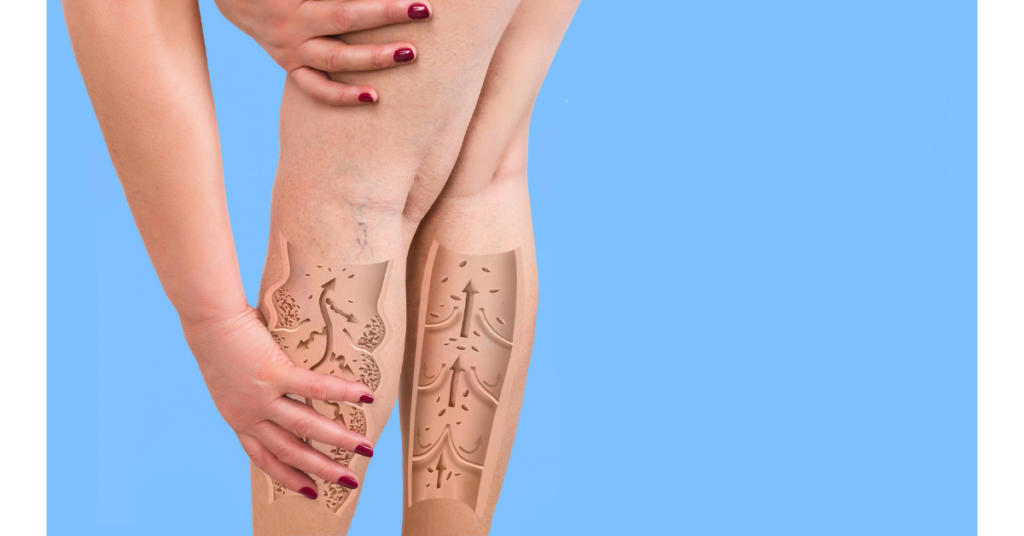What are varicose veins?
If we understand what veins are, then we can understand what it means to have varicose veins. Blood travels round the body by a system of tubes; arteries, veins, and capillaries.
The tubes that lead back to the heart are called veins.
Veins are very similar to arteries, except unlike arteries, veins have valves on their inner walls; this is to prevent blood from flowing back into the arteries.
Sometimes the valves fail to work, or may not work well enough, in which case, the blood accumulates in the veins and causes them to stretch.
Signs and Symptoms
The veins become lumpy and bluish in colour so much so you can see them through the skin. Swelling can occur as they enlarge, and they often itch and when you scratch them. They are very painful, and the legs feel heavy and achy.
Causes
Those who sit or stand for long periods of time are more at risk of developing them due to lack of circulation. It is never wise to sit with your legs crossed and those who lack exercise in their life tend to be at greater risk of developing varicose veins. They are common during pregnancy and with the overweight. Constipation, phlebitis, heart failure, abdominal tumours, and liver disease are conditions that can increase your chances of developing varicose veins, and they are also often hereditary.
Complementary Approach
The following information does not constitute a prescription or recommended dose – studies have been conducted using the dosages stated and are included for your information only.
The nutrients mentioned here are often recommended by healthcare practitioners.
EAT: To avoid getting constipation, it essential that you keep your colon in good clean working order. A diet low in fat is recommended, with plenty of fibre, as well as lots vegetables and fruit.
DON’T EAT: Any saturated fats. These are found in animal fat, butter, cream, gravies, ice cream, rich dressing like mayonnaise and salad cream, whole milk, and any foods that have been fried.
Nutritional Supplements
Bioflavonoids: Promote venous strength. 500 mg twice daily.
Glutathione: Protects veins, heart, and arteries from oxidant damage. Take as directed on label.
Vitamin C: Reduces blood-clotting tendencies, thus improving circulation. Take 3,000-6,000 mg daily.
Dimethylglycine: Improves oxygen utilisation in the tissues. Take 50 mg 3 times daily.
Essential Fatty Acids: Keep blood vessels soft and pliable, therefore, reducing pain. Take as directed on the label.
Herbs that may help this condition
Horse Chestnut: This herb has been traditionally used for venous problems, and studies support its use (1,2,3). It seems that horse chestnut has an ability to strengthen capillaries, therefore, leading to less swelling (4). Take in capsule form, as directed on the label. Alternatively, mix half a teaspoon of horse chestnut powder with 500 ml of water. Moisten a piece of gauze or sterile bandage in the solution and gently rub over the affected area.
Witch Hazel: Used in the treatment of haemorrhoids (5,6) and, therefore, should be good for varicose veins. Apply ointment 3 times a day for at least 2 weeks.
The herbs mentioned here have historically been considered beneficial in the treatment of various conditions including varicose veins, along with the herbs mentioned in the previous section. Therefore, healthcare practitioners often recommend them.
Butcher’s Broom, gotu kola, hawthorn berries, and ginkgo biloba all improve circulation in the legs.
Further Information
For instant relief, lie down with your legs raised.
To improve circulation, take up exercise, this will not only benefit you by getting the circulation going, but you will also burn off calories, thus reducing weight.
References
1. Blumenthal M, Busse WR, Goldberg A, et al, eds. The Completely German Commission E Monographs: Therapeutic Guide to Herbal Medicines. Austin, TX: American Botanical Council and Boston: Integrative Medicine Communications, 1998, 149.
2. Dittler MH, Ernst E. Horse Chestnut seed extract for chronic venous insufficiency: A criteria-based systematic review. Arch Dermatol 1998;134:1356-60.
3. Diehm C, Trampish HJ, Lange S, Schmidt C. Comparison of leg compression stocking and oral horse chestnut seed extract therapy in patients with chronic venous insufficiency. Lancet 1996;347:292-94.
4. Wilhelm K, Felmeier C. Thermometric investigations about the efficacy of beta-escin to reduce postoperative edema. Med Klin1977;72(4):128-34 [in German].
5. European Scientific Cooperative on Phytotherapy. Hamamelidis folium (Hamamelis leaf). ESCOP Monographs on the Medicinal Uses of Plant Drugs. Exeter, UK: ESCOP, 1997.
6. Blumenthal M, Busse WR, Goldberg A, et al, eds. The Completely German Commission E Monographs: Therapeutic Guide to Herbal Medicines. Austin, TX: American Botanical Council and Boston: Integrative Medicine Communications, 1998, 231.

